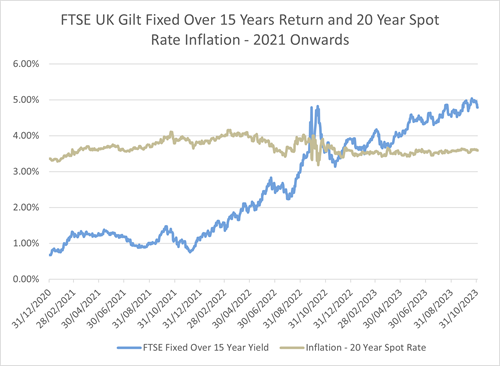Since August 2022 I have been highlighting the ‘window of opportunity’ which exists for charities looking to exit LGPS and that this favourable window is likely to be open for a very limited time period.
I have witnessed many charities take advantage of this over the last year as their funding position has reached a level where they can afford a much smaller exit debt or indeed for some where they have benefitted from very significant cash payments back from Funds.
The graph below shows gilt yields and inflation since 1st January 2021.
Exit (or cessation) debts for most Funds are linked to gilt yields and as yields have risen liabilities, and therefore associated deficits, have fallen. The graph highlights that gilt yields have risen from below 1% in January 2021 to up around 5% currently. Indeed current gilt yields are even now at an equivalent yield to the yields seen in the ill-fated September 2022 mini-budget.
Over the same period while short-term inflation has been volatile longer-term rates have remained reasonably static, which has meant that it is primarily gilt yields which will have the greatest impact on exit liabilities.
Impact of Interest Rates on Exit Liabilities in 2023
Throughout 2023 we’ve seen, until recently, the Bank of England Monetary Policy Committee (‘MPC’) continue to increase interest rates to try to manage short-term inflation. Recent signs have suggested that the rate of inflationary increase has begun to reduce and so the last two MPC meetings have decided to retain interest rates at the same level, ending the long cycle of rate increases.
With the continuing war in Ukraine and the recent conflict in the middle east has meant that asset values have been relatively volatile, their impact on exit liabilities has not been as material as gilt yields.
If, as many analysts expect, we are reaching the end of the interest rate cycle then over time we could expect to see interest rates and therefore gilt yields fall. This would then once again place a higher value on liabilities held in the Funds and therefore a commensurate increase in exit debts.
The example in the table below highlights the position:-
| Gilt yield | 5% | 4% | 3% |
| Asset Value | £5,000,000 | £5,000,000 | £5,000,000 |
| Liability | £4,250,000 | £5,100,000 | £6,100,000 |
| Surplus / (Deficit) | £750,000 | (£100,000) | (£1,100,000) |
| Funding rate | 118% | 98% | 82% |
NB: The figures have been rounded and assume all other factors remain constant.
This shows that the charity could move from a £750,000 surplus position to a £1.1m deficit position with a 2% fall in gilt yields. This would happen over time, and there may be some offset from reductions in inflation, but it does highlight the potential impact of each fall in yields.
One other concern is that I’ve witnessed a move, with some funds, to change the exit calculation basis moving away from a wholly gilts based assessment and this has resulted in very significant increases in exit liabilities which have in a number of cases stopped charities exit objectives in their tracks. It may well be that more Funds choose to review their basis which could equally close this window of opportunity.
Act Now! Secure Your Charity’s LGPS Exit Planning
If you are a charity participating in LGPS and either now have a very small number of active members, which makes a future exit inevitable, or you are just looking to achieve certainty in your pension provision you really should be looking at your options NOW as that window may not be open for much longer. That large lady singer is definitely warming up the vocal chords!
Need Support?
We understand the complexities and nuances involved in charity pension planning. Contact us today and allow our team to provide support and guidance that is tailored to your scheme.


